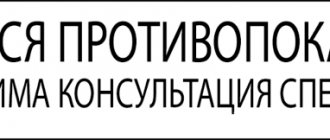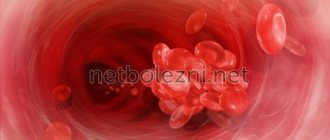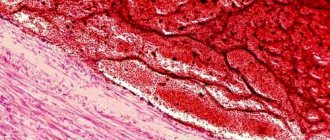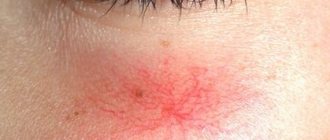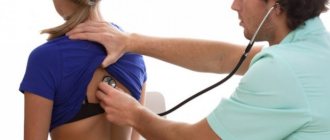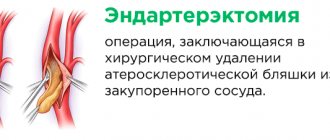Cholesterol plaques in the vessels of the neck (carotid artery) are dangerous, primarily because they impede blood supply to the brain. Cholesterol (atherosclerotic) plaques in the vessels of the cervical spine are formed as a result of poor nutrition (abuse of fatty foods and foods rich in exogenous cholesterol) and a sedentary lifestyle (together - metabolic syndrome). Often atherosclerotic plaques in the vessels of the neck are accompanied by the same in the legs (varicose veins) and on the heart.
Cholesterol plaques in the cervical spine are well diagnosed by ultrasound examination of the intima media thickness (IMT) of the carotid artery (more on the diagnosis of high cholesterol). The presence of cholesterol plaques in the carotid artery indicates their accumulation in the blood vessels and other organs and tissues of the body, including the coronary vessels of the heart (which can lead to the development of angina and heart attack) and in the brain (stroke).
Cholesterol plaques in the neck are formed when there is a high level of low and especially low density lipoproteins (LDL and VLDL) in the blood. In the neck, blood vessels narrow, which facilitates the formation of atherosclerotic deposits here. The resulting plaques can harden over time (atherocalcionosis, calcium accumulation occurs) and burst (if a fresh cholesterol plaque bursts, without calcium, then there is a risk of forming a blood clot - a thrombus).
The main symptoms of cholesterol plaques in the carotid artery are:
- impairment of memory and cognitive functions of the brain;
- headache;
- fatigue and chronic fatigue;
- attacks of dizziness;
- feeling of heaviness in the head;
- deterioration of hearing and vision (including spots before the eyes), speech;
- impaired coordination of movements;
- increased irritability.
Atherosclerosis develops slowly and, as a rule, asymptomatically (there are no symptoms of high cholesterol levels in the blood at all) until a critical mass of atherosclerotic deposits accumulates in the vessels. These symptoms of the formation and accumulation of cholesterol plaques in the carotid artery and vessels of the cervical spine appear only in 60% of observed cases.
The reasons for the formation of atherosclerotic deposits in the blood vessels of the neck are:
- hypertension (high blood pressure) – blood flow acts on the walls of blood vessels like a battering ram, the higher the pressure, the higher the risk of damage to the walls (although hypertension is not the cause of high cholesterol in the blood);
- inflammatory processes in arteries and veins, leading to damage to the endothelium - lipoproteins infiltrate into the appearing “cracks”;
- damage to the vessels of the cervical spine by herpes viruses, cytomegalovirus, microorganisms (for example, chlamydia);
- destruction of blood vessel walls by antioxidants and (or) free radicals;
- obesity and high cholesterol levels in the blood (hypercholesterolemia) – the main building material for atherosclerotic deposits is LDL;
- hormonal disruptions (releases of adrenocorticotropic and gonadotropic hormones, which leads to an increase in the production - synthesis - of endogenous, intrinsic cholesterol).
It should be noted that there are a number of factors that increase the risk that one or more of these causes of cholesterol plaques will lead to their formation. These include physical inactivity (sedentary lifestyle), smoking, alcohol abuse, diabetes, excess weight, high blood pressure, regular stress and emotional stress.
See also:
What kind of alcohol can you drink if you have high cholesterol?
Diet for high sugar and cholesterol
Non-modifiable factors (reasons) for the formation of atherosclerotic deposits in the carotid artery include hereditary predisposition and age.
Treatment of cholesterol plaques on the neck
The method of treating cholesterol plaques in the vessels of the neck is determined by the stage of the disease. It is customary to distinguish several stages of atherosclerosis: at the first - when conservative (non-invasive, i.e. not requiring surgical intervention) methods for removing cholesterol plaques remain effective - fatty plaque forms on the inner walls of blood vessels, and lipids penetrate into the damage to the endothelium. The body reacts to the latter by producing antibodies (macrophages), which “stick around” the lipid formation, gradually forming a plaque.
At the first stage, there may be treatment of cholesterol plaques in the carotid artery through specialized diets for high blood cholesterol levels, exercise, taking drugs to lower blood cholesterol levels (statins), the use of folk remedies and dietary supplements (dietary supplements) based on omega- 3 acids and linseed oil. Fatty plaque in the carotid artery can generally resolve on its own over time, without requiring any treatment. To do this, you should temporarily stop eating sweets, flour and fatty foods.
See also:
Flaxseed oil for atherosclerosis
Dietary supplements for atherosclerosis
Proper nutrition menu for high cholesterol
How to treat cholesterol plaque on the carotid artery at the second stage? The second stage means the formation of fibrin threads (“bridges” of connective tissue) between individual atherosclerotic deposits - it is not always impossible to treat cholesterol plaques that have undergone fibrosis without surgical intervention (it is possible to stop the condition and achieve partial regression of the plaque by taking cholesterol pills). On the other hand, cholesterol plaques in the carotid artery may not require treatment - they can grow to a certain point, after which they enter the stage of zero activity.
Causes and symptoms of the disease
Atherosclerosis causes vascular thromboembolism. The plug is formed due to the presence of fats in the form of salt, calcium, and cholesterol deposits.
The development of the disease is associated with the following reasons:
- increased concentration of glucose in the blood for a long period of time;
- unhealthy diet (fatty, fried, spicy foods);
- consumption of tobacco and alcohol products;
- immobility of the patient;
- high blood pressure;
- age category from 40 and above;
- angiopathy;
- an increase in the synthetic direction of the liver, which leads to the entry of endogenous cholesterol into the blood;
- past infectious diseases.
Similar pathologies of the blood vessels of the head and cervical regions appear at 30 years of age.
Atherosclerosis of the arteries of the neck is determined by symptoms:
- Muscle weakness, dizziness.
- Pain in the neck, head, back, lumbar region.
- Insomnia.
- Decreased visual acuity.
There are dangerous violations:
- numbness of the upper and lower extremities;
- suspension of the patient’s speech, asymmetry of the facial muscles;
- paralyzed right or left area of the body;
- spontaneous loss of vision;
- loss of consciousness for no reason, pale skin, increased sweating.
The situation requires urgent contact with a specialist to avoid brain damage.
Removal of cholesterol plaques in the carotid artery
Removal of cholesterol plaques on the carotid artery at the second stage (fibrosis) and at the third stage (calcionosis) can occur in several ways:
- increasing blood (arterial) pressure - but this path is fraught with the formation of new damage to blood vessels and, as a consequence, the formation of new atherosclerotic deposits;
- dilatation of blood vessels, however, this method is ineffective on the carotid artery and is used more often for varicose veins of the extremities;
- increased tone of blood vessels;
- cleansing the blood of cholesterol - however, this method does not so much destroy existing plaques as prevent the formation of new ones.
The cost of removing cholesterol plaques on the carotid artery using medications is entirely determined by the cost of the drugs used. The cost of surgical treatment (carotid endarterectomy, angioplasty, stenting) is even higher if it is not done according to the insurance policy. Surgical treatment is resorted to when conservative methods fail.
Conservative methods of removing cholesterol plaques include taking specialized medications, increasing the proportion of foods in the diet that cleanse blood vessels of cholesterol, performing (daily) therapeutic exercises for atherosclerosis, and taking statins or other medications for high cholesterol.
How to remove cholesterol plaques from the carotid artery safely? Surgery has some risks, and drug treatment has contraindications and side effects. Drug treatment can be aimed at reducing the level of cholesterol synthesis by the liver, increasing energy metabolism in cells - this is how it is possible to remove excess cholesterol from the blood and carotid arteries. An alternative is infusions and herbs for cholesterol plaques, but their effectiveness remains unproven.
Traditional methods of therapy
Cleaning blood vessels from cholesterol will help prevent unpleasant consequences. It will get rid of cholesterol plaques, restore elasticity and elasticity to blood vessels, and prevent the development of atherosclerosis, myocardial infarction and stroke.
After cleaning, headaches go away, blood pressure normalizes, cholesterol concentration decreases, mood improves, performance increases, and the body is charged with energy.
Cleansing blood vessels helps maintain the cardiovascular system in excellent condition, which promotes health and longevity.
It is recommended to clean the vessels once a year.
Usually, to clean blood vessels, doctors prescribe medications that reduce the concentration of lipids in the blood and increase the elasticity of blood vessels. But medications often have side effects.
Folk remedies that can be combined with drug therapy will help to effectively cleanse blood vessels.
Garlic and lemon are especially often used to destroy cholesterol plaques.
It is better to clean in the fall, after harvesting a new crop. At this time, garlic is more saturated with useful substances.
The effective action is possible due to the strong antioxidant properties of garlic and the high content of ascorbic acid in lemon.
Garlic has an excellent anti-sclerotic effect. It is able to effectively cleanse blood vessels of cholesterol deposits. It’s not for nothing that Caucasian cuisine is generously seasoned with garlic, and Caucasians are famous for their excellent health and longevity.
Lemon juice helps improve the elasticity and firmness of blood vessels.
The leaders in cleaning blood vessels from cholesterol are garlic and lemons.
There are many recipes using garlic and lemon:
- Wash the lemon thoroughly and pass it through a meat grinder along with the peel. Add water (1 liter) and leave for three days. Take 50 milliliters 20 minutes before meals.
- Freshly squeezed lemon juice (from 1 kilogram of lemons) is thoroughly mixed with garlic gruel (200 grams). Leave in a cool, dark place for 3 days. Take 20 grams, stirring with water. Drink once a day until the product runs out.
- The cleaning course lasts 40 days. It will require 16 heads of garlic and 16 unpeeled lemons. The treatment is done every week. To prepare the infusion, grind 4 lemons and 4 heads of garlic using a meat grinder. The resulting mixture is poured with boiled warm water and left to infuse for 3 days at room temperature. The infusion is placed in the refrigerator and consumed 100 grams 3 times a day before meals. If you have any chronic diseases, the dose should be reduced to 20-50 grams.
- Freshly squeezed juice obtained from 10 lemons is mixed with honey (1 liter) and gruel from 10 heads of garlic. The mixture is infused for a week in a dark place. The medicine is taken once a day on an empty stomach, 20-40 grams for 2 months.
- Grind garlic (200 grams), onions (1 piece) and lemons (3 pieces) using a blender or meat grinder. Mix everything thoroughly, adding honey (250 grams). Take 20 grams before meals.
- Chopped garlic (250 grams) is mixed with horseradish and lemon in equal proportions. The mixture is poured with warm boiled water (100 milliliters) and left in the refrigerator for a day. Drink 20 milliliters 30 minutes before meals 2-3 times a day, eating honey.
Cleaning blood vessels with garlic and lemon from cholesterol and salts
This remedy came from Tibetan monks.
Garlic (350 grams) is crushed using a garlic press and poured with alcohol (200 grams). The mixture is left for 10 days in a dark place at room temperature to infuse. The strained liquid is infused for another 3 days.
Use the remedy 3 times a day 30 minutes before meals for 11 days.
Start drinking the tincture with one drop, increasing the amount by one drop each time. From the afternoon of the sixth day, the number of drops begins to decrease and is brought to one in the evening of the tenth day. On the eleventh day, drink 25 drops 3 times.
A slightly different dosage regimen is also used: with each dose, the number of drops is increased by one. On the 24th and 25th days, drink 25 drops.
Sometimes it is advised to use the product for another month: 3 times a day, 15 drops.
Another recipe is also known. Garlic (150 grams) is crushed, poured with alcohol or vodka (150 milliliters) and left for 10 days in a cool, dark place. The strained infusion is infused for another 4 days. Drink 10-15 drops three times a day, half an hour before meals, for 1 month.
You can add the tincture to milk or water (50 milliliters).
When cleansing blood vessels using the Tibetan method, you need to drink more still water, give up alcohol, fatty and fried foods. It is recommended to use the product once every 3 years.
After the procedure, the body will be significantly rejuvenated (by 5-7 years). The Tibetan method will help you stay healthy, vigorous and young for many years.
Bay leaves perfectly clean blood vessels and joints, strengthen the immune system, and remove waste and toxins from the body. They are rich in a variety of beneficial substances.
- Bay leaves (7 grams) are poured with water (500 milliliters) and boiled for 5 minutes over low heat. Leave for 4 hours in a thermos. Drink a little throughout the day between meals. Cleaning continues for three days.
- Grind 1 lemon and 2 heads of garlic in a meat grinder. Vodka (1 bottle) is poured into the resulting slurry and 5 bay leaves are added. Leave to infuse for a month. Take 10 grams of tincture three times a day after meals.
Bay leaves will not only destroy cholesterol plaques, but also remove waste and toxins
Herbal infusions will provide effective results:
- St. John's wort, chamomile, birch buds and immortelle (100 grams each) are ground and mixed. A mixture of herbs (20 grams) is poured with boiling water and left for 30 minutes. Then the infusion is filtered and the grounds are squeezed out well. Divide the infusion into 2 parts. The first part is mixed with honey (5 grams) and drunk before bed. The second part is placed in the refrigerator, and in the morning it is heated, honey is added and drunk. Use the product until the herbs run out. Repeat every 5 years.
- Mix cudweed, motherwort, meadowsweet and rose hips in equal quantities. The resulting mixture (80 grams) is poured with boiling water (1 liter) and left for 8 hours. Drink 100 milliliters 3-4 times a day for 2 months.
- Combine meadow geranium grass, sweet clover flowers and Japanese sophora fruits. The herbal mixture (40 grams) is steamed with boiling water (500 milliliters) and left to infuse overnight. Drink 70-80 milliliters 3-4 times a day for 1.5-2 months.
- Carefully grind the barberry bark and roots (20 grams). Then brew them with boiling water (half a liter) and leave for 4 hours. Take the medicine 100 milliliters before meals 3-4 times a day.
- The roots of cyanosis (20 grams) are poured with water (300 milliliters) and brought to a boil. Reduce the heat and leave the broth on the stove for 30 minutes. Take 20 milliliters 3 times a day 2 hours after eating and again before bed. Cleansing continues for 21 days. The decoction will not only destroy cholesterol plaques, but also calm the nerves and relieve insomnia.
- Crushed licorice roots (40 grams) are poured with boiling water (500 milliliters) and simmered over low heat for 10 minutes. Take 80 milliliters 4 times a day after meals. The course is continued for 2-3 weeks. After a month's break, the course is repeated.
- The fruits of Sophora japonica (100 grams) and mistletoe grass (100 grams) are crushed and poured with vodka (1 liter). Leave in the dark for 3 weeks. Drink 5 milliliters three times a day before meals (30 minutes before). The tincture cleanses and strengthens blood vessels, accelerates cerebral circulation. Sophora rids blood vessels of cholesterol, and mistletoe removes toxins, radionuclides and heavy metal salts.
- The leaves of the golden mustache are cut, poured with boiling water and left for a day. Drink 20 milliliters 3 times a day before eating. The infusion will cleanse blood vessels of cholesterol, lower the concentration of sugar, and resolve cysts on the kidneys.
Kvass
Kvass from jaundice will help to effectively cleanse blood vessels of cholesterol. Dry crushed grass (50 grams) is placed in a gauze bag, a weight is attached to it and cooled boiling water (3 liters) is poured over it. Add sugar (250 grams) and sour cream (5 grams). Leave in a warm place for 2 weeks to ferment.
Drink healing kvass three times a day, 30 minutes before meals, 120 milliliters for a month.
The product will help lower cholesterol levels, stabilize blood pressure, get rid of noise in the head, and improve memory and mood.
Clover
Red clover is great for cleaning vessels. It is considered the most effective herbal remedy used for the prevention and treatment of diseases of the cardiovascular system.
Dried flowers are poured with vodka and, covered with a lid, left in a cool, dark place for 3 weeks. Take three times a day before meals. Drink 30 drops, diluted in water or tea for a month and a half. After a ten-day break, the course is repeated.
You can make medicine from clover without alcohol. For this, clover inflorescences (40 grams) are poured with boiling water (250 milliliters) and drunk throughout the day instead of tea. You can add honey.
Linden
Dried linden flowers are ground into flour. Take 5 grams 3 times a day for a month with water. After a two-week break, the course is repeated.
How to remove cholesterol plaques from the carotid artery
The decision on how best to remove cholesterol plaques on the vessels of the neck and carotid artery is made based on the results of an examination by a cardiologist, ophthalmologist, neurologist, nephrologist and vascular surgeon. Stress tests, ECG, coronography, ultrasound of the aorta and heart vessels, angiography are prescribed. Duplex and triplex scanning allows assessing blood flow in the carotid artery. An MRI may also be required to visualize the vessels and plaques in them.
To remove cholesterol plaques in the vessels of the cervical spine, lifestyle changes and drug therapy will be prescribed.
You may have to give up some of your habits:
In large quantities, alcohol increases blood cholesterol
Natural coffee affects cholesterol
You can eat eggs with high cholesterol up to 3 eggs per week
Diet for cholesterol plaques in the carotid arteries
The diet for cholesterol plaques in the vessels of the neck is preventive in nature and involves avoiding fatty foods (animal fat is the basis of the “building material” for the formation of endogenous cholesterol) and foods high in cholesterol (exogenous). Also, the diet includes a large amount of plant foods (at least 400 grams or, based on pure fiber - soluble and insoluble - up to 30 g).
Also effective: flaxseed oil and flaxseeds, omega-3 and, to a lesser extent, omega-6 acids (found in cold-water fish and fish oil). Vitamin C, garlic (essential oils) have not shown any significant effect against atherosclerotic deposits, but they are effective against inflammatory processes, which are often the root cause of damage to blood vessels and, consequently, the formation of plaques.
See also:
Reviews of folk remedies for cholesterol
Garlic for atherosclerosis
How to get rid of cholesterol plaques with folk remedies
Does aspirin help against the formation of cholesterol plaques?
Drugs such as statins, fibrates, nicotinic acid and bile acid severstants have stabilizing properties - these medications are not able to destroy atherosclerotic deposits, but can slow down or suppress the formation of new deposits.
Prevention
During a general examination, the doctor identifies the following physiological signs of the disease:
- Increased hairiness of the auricle;
- Pathology of toenails;
- A large number of wen;
- Swelling;
- Hair loss;
- Sudden and severe weight loss without dieting or exercise.
After the examination, systolic murmurs and heart sounds are heard, and internal organs are palpated. When collecting anamnesis, the presence of obesity, high blood pressure and hypertension, and diabetes is determined. The patient’s lifestyle, working conditions, and nutrition play an important role. These factors contribute to the development of vascular atherosclerosis and complications.
Laboratory diagnosis of carotid artery stenosis begins with a general and biochemical analysis of blood and urine. A large amount of homocysteine in the blood leads to damage to the internal walls of blood vessels and the onset of cholesterol deposition. The normal value of this indicator:
- For men - 5-15 µmol/l;
- For women - up to 12 µmol/l.
Triglycerides are insoluble fats that are carried through the blood by very low-density lipoproteins. An excess of the normal value (1.7 mmol/l) indicates a high risk of atherosclerosis. The atherogenicity coefficient is used to judge the development of atherosclerosis complicated by cardiac ischemia. It is calculated as the difference between total cholesterol and HDL cholesterol, divided by the level of high-density lipoproteins. Its norm is 1.98-2.51. The higher the coefficient, the higher the risk of death from the disease.
If the cholesterol level is exceeded, an additional test for apoliprotein is prescribed. Its norm is 1.08-2.25 g/l for women and 1.04-2.03 g/l for men. Reduced levels indicate a lack of good cholesterol and the risk of developing atherosclerosis of the cervical arteries.
Normal lipoprotein levels:
- LDL - 2.1-4.7 mmol/l;
- VLDL - 0.2-0.5 mmol/l.
- For total cholesterol, which includes all lipoprotein fractions, the norm is set at 3.5-5.2 mmol/l.
When analyzing urine, the level of lactate dehydrogenase is determined, which characterizes the processes of glucose metabolism. If the indicator is exceeded (the norm is 120-246 U/L), then this indicates the development of additional ischemia and the risk of myocardial infarction.
After laboratory tests, additional instrumental diagnostics are prescribed. It depends on the symptoms of the disease and the age of the patient, the presence of third-party chronic diseases.
Angiography, or contrast X-ray, involves injecting a contrast agent into the vessels through a catheter and then scanning it with X-rays. The method allows you to assess the condition of small and large blood vessels, the presence of atherosclerotic seals. The procedure is prohibited in case of allergy to iodine, acute mental disorders, cardiac, renal or liver failure, pregnancy and lactation. After angiography, the first meal should be 8-10 hours later.
Using CTA (computed tomographic angiography), the vessels of the brain and neck are examined. This method allows you not only to find out their condition, but also to determine the speed of blood flow. Due to lower radiation, tomographs have only a few contraindications. These include:
- Claustrophobia;
- Arrhythmia;
- Patient weight: Some models are designed for weights up to 100 kg.
Ultrasound is used to examine the arteries of the heart and carotid arteries. The method is based on the study of blood vessels using ultrasonic waves. When they pass through areas of different densities, a change occurs in the wave and its reflection. The sensor records these changes, and the processor converts them into a picture on the monitor. Ultrasound is a simple and accessible diagnostic method that has no contraindications or restrictions for its implementation.
Another diagnostic method is Doppler ultrasound. This is a combination of ultrasound with the Doppler function, which allows you to assess the patency of the arteries, the speed of blood flow through the vessels and measure the degree of stenosis of the vascular lumen.
MRI is one of the modern and more advanced diagnostic methods that allows us to examine the processes occurring in the body. The patient is placed in a capsule equipped with magnets. Using special software, the condition of blood vessels and arteries is reflected on the monitor screen in real time.
The main preventive measure is maintaining a healthy lifestyle. Organizing a healthy diet for vascular atherosclerosis is necessary for successful treatment, preventing the development of complications, and slow weight loss. The diet is aimed at limiting and eliminating from the diet foods that increase cholesterol in the blood.
The ban includes fatty meats and fish, cheeses, dairy products, smoked and fast food, and canned food. It is worth limiting baked goods and sweets, products made from wheat flour. Fried foods should be replaced with steamed or oven-cooked foods.
Cereals are useful for atherosclerosis of the neck arteries, especially buckwheat, bulgur and wild rice. It is better to avoid regular white rice. It is advisable to include more vegetables, fruits, and fresh herbs in your daily diet. Broths can be made from lean turkey or veal meat, vegetables, and fish. Rich soups are allowed to be eaten no more than 2 times a month.
Prevention and treatment of the disease involves maintaining water-salt metabolism. This means avoiding salty foods: the maximum daily salt intake is 5 g. You must drink up to 2.5 liters of water. This volume does not include tea, juices, dairy drinks, infusions and decoctions. Only clean water helps thin the blood and remove toxins and waste from the body.
Giving up bad habits is also an important part of disease prevention. Smoking stimulates the development of vascular disease, increases blood pressure and heart rate, provokes active deposition of cholesterol cells on the walls of blood vessels and lowers the level of oxygen in the blood. In diabetics, with vascular damage, 2 minutes after smoking a cigarette, a decrease in blood flow by 20% is observed and the development of angina attacks.
To prevent the development of the disease, it is necessary to increase daily physical activity. Long walks in the fresh air, swimming, skiing, physical therapy, yoga, various types of aerobics and dance aerobics, horse riding and cycling are useful.
Typically, atherosclerosis develops against the background of factors such as poor nutrition and frequent stress, excess weight, hypertension or diabetes. Symptoms of the disease in the early stages are mild and can be confused with overwork. Diagnosis and treatment of atherosclerosis depends on the stage of the disease, the strength of symptoms, age, weight and individual characteristics.
When making a diagnosis, laboratory and instrumental research methods are used. If the disease is not in an advanced stage, then drug therapy is prescribed. A difficult situation that threatens the patient's life requires surgical intervention. In addition to medications, diet and physical therapy are prescribed to improve blood circulation, lose weight and increase the body's resistance.
You need to eat more vegetables and fruits
If you pay attention to your own health, you can prevent many troubles using preventive measures.
The main thing in this matter is not to wait for the development of atherosclerosis, but to try to prevent it. What is needed for this? You need to change your usual lifestyle.
- stop drinking and smoking;
- go on a diet that will help reduce the concentration of cholesterol in the body;
- Physical labor and sports will help you get rid of excess weight;
- drink more clean water to increase your metabolic rate;
- give up coffee, you can only have 2 cups a day;
- after 40 years of age, undergo examinations and donate blood tests. This will help to detect incipient atherosclerosis in time.
Attention! Proper nutrition during the development of atherosclerotic plaques in the blood vessels of the neck is the key to a long life.
- Eat more vegetables and fruits containing vitamins and minerals. Use legumes and whole grains. Reduce your intake of sweeteners, salt and refined grains.
- Add edible seeds and nuts to your menu. They contain vitamin E, mono- and polyunsaturated fats, and other healthy ingredients.
Important! Nuts contain a lot of calories, 250 per 40 g of product. Don't overdo it to avoid becoming obese.
- Eliminate fatty meats from your diet, eat only rabbit, chicken, and turkey fillets.
- Drink less coffee. You can replace it with teas, with the addition of medicinal plants.
Important! Adjusting nutrition can help at the initial stage of development of atherosclerosis. In more severe cases this is not enough.
Surgery to remove cholesterol plaques in the neck
Surgical intervention (operation) to remove cholesterol plaques in the vessels of the neck is prescribed when drug treatment methods have not brought (or cannot bring) any effect, or if the underlying disease has led to complications. Surgery to remove cholesterol plaques in the neck does not lead to a complete recovery, because... It is not the cause of the disease that is eliminated, but its consequence.
Surgery to remove cholesterol plaques on the carotid artery is called a carotid artery bypass. The purpose of the procedure, as well as the determination of possible risks to the health and life of the patient, is carried out by a surgeon, cardiac surgeon and vascular surgeon. As a result of the operation, the patency of blood vessels is restored, i.e. revascularization is performed.
An alternative to surgery to remove cholesterol plaque in the carotid artery is stenting a blood vessel - this is a low-traumatic procedure in which a stent is installed in the artery, expanding the lumen of the vessel, and special membrane filters. The membranes filter blood from microthrombi, but do not interfere with blood circulation in the brain.
Symptoms
Atherosclerotic plaques in the vessels of the neck are a fairly common occurrence. The vessels in this section are susceptible to damage; moreover, they are quite thin and experience constant pressure from stress. Due to the small caliber of the vessels, a person begins to notice symptoms much earlier than with atherosclerosis of larger arteries.
Also, with plaques in the cervical region, loss of strength, fatigue, decreased memory, and a feeling of heaviness in the neck and head are observed.
The acute form is quite dangerous, since it can lead to cerebral infarction or hemorrhagic stroke (bleeding in the brain). Quite often these diseases are the cause of early death. The manifestation of the disease begins with the appearance of fatigue when performing a small amount of work, soon after this headaches appear, and dizziness is possible.
The chronic form of cervical vasoconstriction has a more obvious clinical picture, which is divided into three stages:
- During the first stage, the patient’s ability to work decreases, which can be attributed to many factors, so not all people rush to the doctor when they have this symptom.
- In the second stage, the body’s condition worsens - the functioning of the urinary system or musculoskeletal system is disrupted. The last symptom is more noticeable to others, as it provokes a change in gait.
- At the third stage, brain function deteriorates: the patient’s coordination is impaired, he becomes sluggish, the musculoskeletal system almost completely ceases to function, and his mood often changes. The listed symptoms last no more than 24 hours.
Often, a cholesterol plaque in a neck vessel is called a “silent enemy” that does not make its existence known for a long time. For years, or even decades, a person may not suspect an increase in the amount of cholesterol deposits. If we talk about the symptoms that may appear during the disease, they are as follows:
- Frequent headaches, dizziness.
- General weakness.
- Fast fatiguability.
- Numbness of the limbs.
- Floaters in the eyes.
- Decreased visual acuity.
- Insomnia.
- Lack of feeling of stability while walking.
- Apathy.
Treatment of neck vessels due to the accumulation of cholesterol plaques can be traditional and non-traditional. In any case, you need to seek help from a general practitioner who will prescribe diagnosis and therapy. The more lipid deposits, the more pronounced the symptoms will appear.
